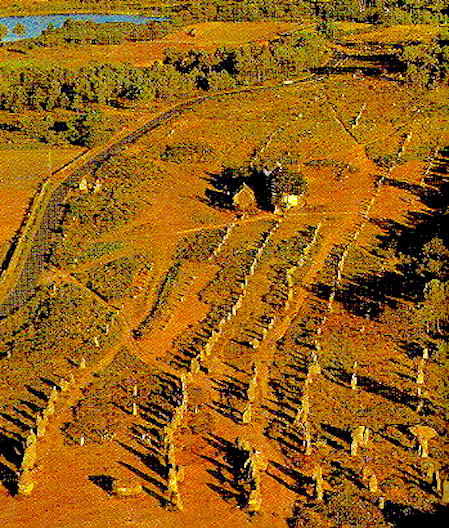Museum of the Origins of Man
POST-PALEOLITHIC PLACES OF WORSHIP WITH SCULPTURE IN THE LOWLANDS
 Fig. 29A1) Places of worship in the lowlands with alignments of menhirs.
Fig. 29A1) Places of worship in the lowlands with alignments of menhirs.
The menhirs of Carnac are of four types: anthropomorphic, zoomorphic, with harmonious elaboration in an abstract sense and simply sketched. Menhirs made of simple stones are very rare.
These four types of menhirs can be considered sculptures in all respects: the most interesting are the anthropomorphic and zoomorphic ones.
This is certainly the most important post-paleolithic prehistoric place of worship in the world.
The alignments are in Carnac, Morbihan, Brittany, France and extend for 3 km in east-west direction; they are divided into three groups: Menec, with 1169 menhirs; Kermario, with 982; Kerlescan, with 579.
On the exact meaning of these menhirs, a consideration that all agree is about the size of some of them and the number of men who had to partecipate in the transport and erection, from which it is inferred that they were public monuments.
Nothing suggests that these are graves. Perhaps the menhirs were memorials of men and events.
The area of these alignments is considered as a "place of worship": which all scholars agree on.
The opinions that divide them, however, are basically of two types. Some consider these aligned menhirs as simple stones; they attribute their origin to the third millennium BC, and link them to Solar cults. These opinions date back more than half a century; no progress has been made, and that is what is taught at school.
The second current of study, which we share, put the origin of the menhirs in the Paleolithic, considering that they are anthropomorphic and zoomorphic, ie authentic sculptures made in a wide range of styles. As far as the religious aspect, we hypothesize that the typology is wide, just like the typology of the same menhirs; but we do not exclude also the manifestations of Solar cults, practiced in the third millennium.
In this site you can find some anthropomorphic and zoomorphic menhirs in Carnac.
NEXT
Index
HOME PAGE
Copyright©1999-2020 by Museum of the Origins of Man, all rights reserved.

